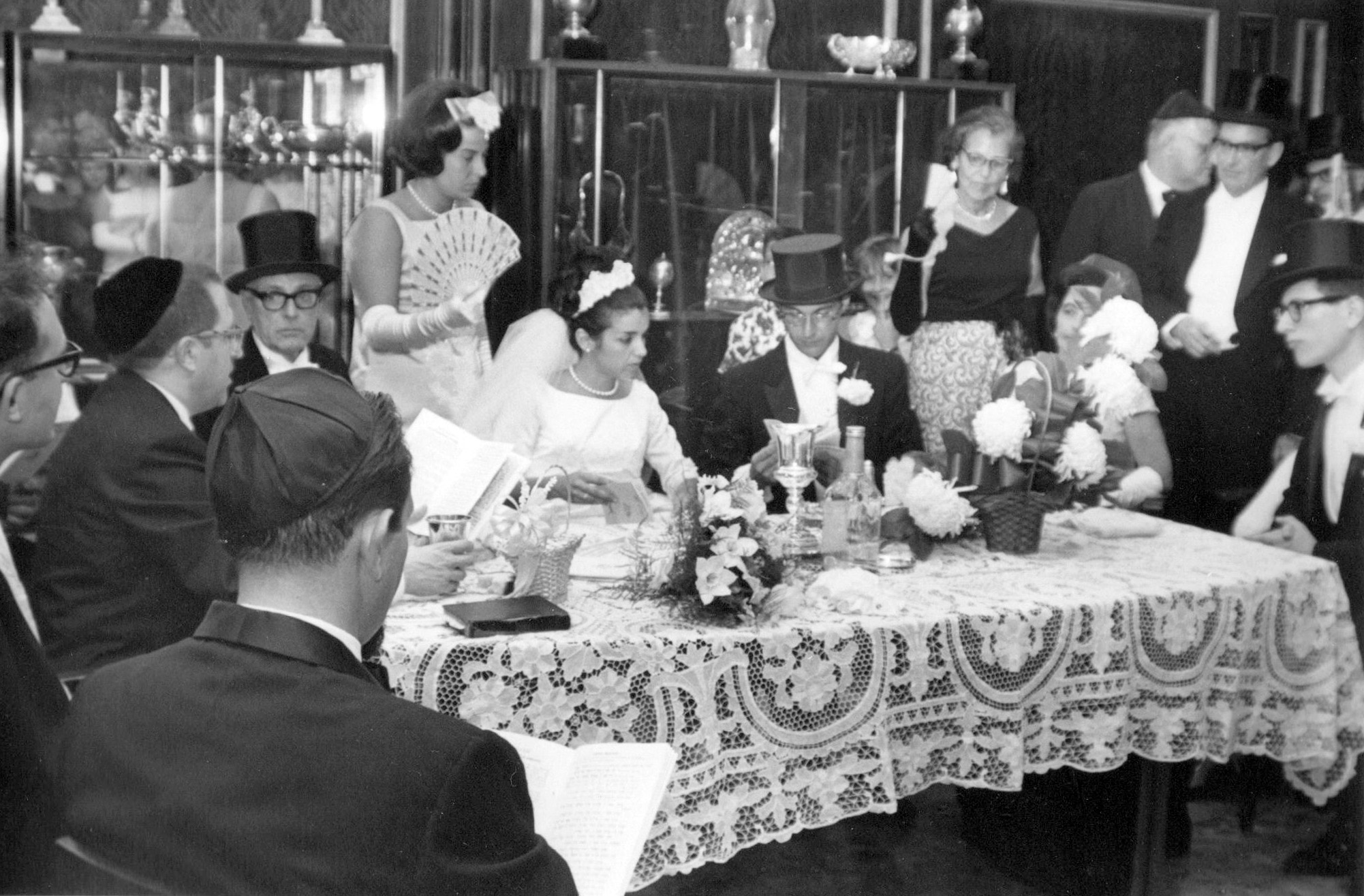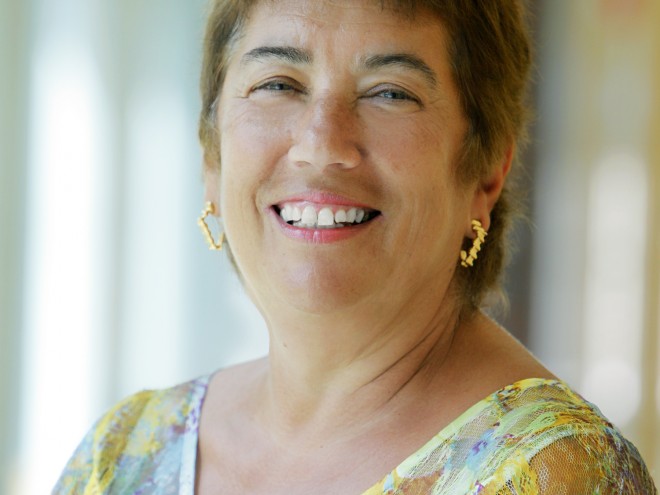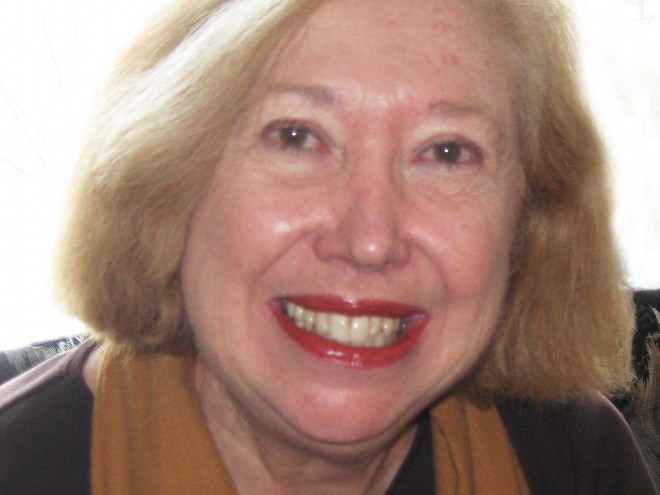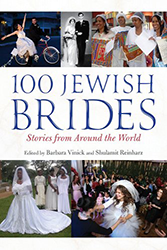
Esther and Steeve under canopies carried by bearers at the henna party
All photos courtesy of the publisher
We embarked on our third cultural project — Jewish weddings from the bride’s point of view. Do Jewish weddings vary in diverse international communities? Are particular features always present? As was the case in our previous projects, we found enormous variation in every aspect of the Jewish marriage ritual, from a brief ceremony in a home or rabbi’s study to weeklong rituals and elaborate shindigs.
In the case of our stories about weddings, we have arranged our material in two ways: by stages of the wedding process and by special topics. The “stage” structure we developed derived from what the women (or their surrogates, including their mothers and daughters) told us about the process of Jewish marriages. Our book — and many of the stories we collected — starts with how Jewish brides met their partners. Next, we highlight courtship and engagement or betrothal. Stories that concern brides’ conversion to Judaism before marriage come next. Subsequent chapters deal with invitations to the wedding ceremony, how the bride or others selected the venue for the wedding, special activities that occurred before the ceremony, and the ketubah (wedding contract). The ceremony itself played a large role in most of the stories, but we chose some of the most fascinating examples for that chapter. Our final chapter within the “stages” framework deals with customs that took place shortly after the wedding.
As you will see, these testimonies are not devoted exclusively to one stage of the journey to the bimah and beyond; we could have placed many stories in multiple chapters. Our decisions were based on elements that were unique, interesting, or particularly relevant to that story.
Because our Jewish brides’ stories come from all over the world and from previous eras, we decided to create separate chapters for special topics, particularly circumstances that varied significantly from the norm, such as arranged marriages and Jewish weddings that occurred during or shortly after the Holocaust. We also decided to create a separate chapter for stories of weddings in Israel because Israeli weddings are currently the subject of intense and even acrimonious debate and policymaking. Because Jewish intermarriage is pervasive around the world, except for in Israel, and steadily increasing, we have two chapters on the topic that focus on prenuptial conversion and intermarriage, respectively.
It is our hope that readers of this book will enjoy learning about how Jews marry — and used to marry — around the world and may get some ideas about how they want to celebrate their own marriage. Readers may not be aware of the existence of all of these Jewish communities. Simply learning about them is eye opening. Focusing on marriage shows us that Jewish life is always in flux over time and space. Weddings now reflect the tastes and interests of the couple as much as they do Jewish law and customs.
Barbara solicited stories from women around the globe who came from diverse Jewish communities, some well known and others unfamiliar to mainstream Jews, and gave them few instructions: include the place and date of the wedding, attach a photograph, and limit the story to about one thousand words. (She interviewed in person or remotely a few women who declined to write their stories but wanted to have them included.) When we received the stories, she edited them as lightly as possible and sent them back to the authors for approval. Then the two of us sat down to analyze and organize what had been sent to us.
As it turned out, women did not limit their stories to the wedding ceremonies but rather placed their marriages within the context of a larger narrative of their lives. Most included how they met their partner and how their lives have evolved since they married. We also discovered that many women wanted to write the stories that had come down to them of their mother’s or grandmother’s wedding — some in amazing detail. When they did not find their own wedding particularly interesting, they wrote about someone else’s — as long as a Jew was involved — such as a cousin’s or a congregant’s. People wanted to write a story that had an interesting twist. Some wrote about why they rejected old customs with which they no longer identified, and others wrote about why they chose to perpetuate these customs, some of which had been adopted through the ages from their non-Jewish neighbors. All in all, the stories are reflections of the way people understand Jewish weddings, with their joys, strains, and variations. This is not a complete compendium of wedding customs — that would probably require an encyclopedia. Rather it is a glimpse into the stories that brides tell about one hundred Jewish weddings from eighty-three countries in many historical eras. In summary, this collection represents a larger project of learning about how Jewish life was and is actually lived around the world by hearing about women’s activities and listening to their voices.
Morocco
Rachel Jacobson
Moroccan Jewish wedding events might be the most elaborate in the world. As in other countries, some Middle Eastern Jewish wedding traditions are similar to those of the surrounding culture — the henna party, the prewedding trip to the hammam, the multiple changing of caftans during wedding events, the bride’s entrance on a kind of throne, and the scrumptious items of cuisine. The blessing of the guests by the bride before the wedding ceremony is a traditional Jewish custom, while the priestly blessing of the guests that Rachel mentions is a less common element. Rachel, who has not forgotten her Moroccan roots, teaches Hebrew and Jewish studies in the Boston area, where she has lived for more than forty years.
My great-nephew Steeve married his wife, Esther, in 2007 in Casablanca. Steeve’s grandmother, Marie, is my oldest sister. She is the only one of our twelve brothers and sisters who stayed in Morocco. The whole family left for Israel in 1948, before I was born. Marie was seventeen and already married.
For the most part, the Jews of Morocco are well-off financially and have been protected by several generations of rulers. Like his father and grandfather, the current king, Mohammad VI, has supported the Jewish community and has worked behind the scenes for Arab-Israeli peace. Although there have been isolated instances of violence, antisemitism is not evident. Like my sister Marie’s family, everyone in the Jewish community follows the same modern Orthodox practices. They all keep strictly kosher and are shomer Shabbat (keepers of the Sabbath). They all send their children to Hebrew day schools, which are known to be the best in the country.
I arrived from my home in the United States a week before the wedding, joining some of my siblings who were able to come from Israel and other parts of the US. I missed the engagement party but went to many other traditional celebrations for Steeve, who was twenty-seven, and his bride Esther, who was twenty-one. (Often in Morocco, the bride is much younger than the groom.)
The mikveh was a low-key affair attended by women only — about fifteen to twenty close family members and friends. After immersing, Esther put on a beautiful, embroidered caftan with bright cheerful colors. There was a lot of singing and the comfort of being together before the elaborate marriage celebrations. Along with many other special pastries, my favorite was served — baby eggplants candied in honey and sugar.
For his part, my great-nephew was the center of a Shabbat Hatan (groom’s Shabbat), which is held in the synagogue the Shabbat before the wedding, when the groom-to-be is called up the Torah and the family receives congratulations.
I was there for the ketubah signing four days before the wedding, when the groom’s family brought him to the bride’s home, walking through the streets, accompanied by the loudest drums and horns I ever heard. There was so much noise! At the bride’s home, they signed the ketubah, along with the rabbi and two witnesses who traditionally are not family members. Both Esther and Steeve received expensive gifts from their future in-laws.
Next was a huge henna party for five hundred people in Marrakesh, two hours away, sponsored by the groom’s family. The women wore gorgeous caftans (I bought one in Morocco) and many of them changed garments four or five times during the course of the event. The bride entered the ballroom on a canopied throne carried on poles on the shoulders of four men. The groom entered the same way, dressed in a white tarboosh (tasseled hat) and a white jalabiya (long robe). There was a French band and a Moroccan band, and singers who sang in French, Arabic, and Hebrew. As the bride and groom sat under their canopies, they were showered with lavish gifts, which were shown to all the guests. The bride received bracelets, necklaces, and earrings, which she put on until she was covered in gold and diamonds. Then a family member applied henna to the palms of all the guests — women and men — who wanted it. This is a testament that the couple is willing to marry, and, as henna stains the hand for as long as six months, that they will not be forgotten and are blessed. There was nonstop eating and entertainment in every corner until the early hours of the morning.
The day before the wedding, twenty women went to the hammam, the steam bath. We went into a huge room filled with steam and laid down on wooden beds. For forty-five minutes, someone used a special brush to peel the dead cells from my skin. It’s amazing to see what comes off! Then creams are applied, and you feel that you have baby skin.
On the day of the wedding ceremony, the bride traditionally blesses every person who needs help, laying her hand on the person’s head. On that day she is closest to G‑d and is pure. There were three hundred people in the Great Synagogue of Casablanca, the women and men sitting separately. Family members and attendants came down the aisle ahead of the bride, who was veiled and wearing a simple white bridal gown without jewelry, which was her choice. Rabbi Lau, the Chief Rabbi of Tel Aviv, officiated, reading the ketubah. Under the chuppah, the bride circled the groom seven times, and members of the family read the sheva brachot. At the end, the bride came close to the ark for the birkat kohanim, the priestly blessing. Women cannot look and have to shield their eyes. Then off to a very fancy reception at the Hyatt Hotel for even more guests, where there was music, dancing, kosher Moroccan food, and incredible desserts.
For a week after the wedding, people hosted the family for sheva brachot (seven benedictions, like those recited under the chuppah). Every night we went somewhere else, including the Chabad house. When I finally returned home, I was completely exhausted!

Sheva Brachot ceremony in the Sala Consistorial
Curaçao
Josette Capriles Goldish
The first Jews, originally from the Iberian Peninsula, arrived in Curaçao in the 1600s from the Netherlands. They established historic Congregation Mikvé Israel-Emanuel, the oldest synagogue in continuous use in the Americas, where Josette and her husband were wed. The sand floor, one of four in the Caribbean, is well known to thousands of tourists who visit the island each year, reminders of the desert wanderings of biblical Jews and homage to Jews of the Inquisition who used sand to muffle the sound of their prayers. If you thought that Jewish grooms, both Ashkenazic and Sephardic, universally step on a glass at the end of the wedding ceremony, think again. Josette’s story documents unusual local customs regarding wedding glass-breaking as well as inviting guests.
The strains of “Baruch Ha’ba” float down to the courtyard of the historic Mikvé Israel-Emanuel synagogue where I am waiting with my father to walk into the main sanctuary on the evening of my wedding. These first introductory notes coming from the organ are my cue. Remember to walk slowly, remember to smile, and for heaven’s sake, don’t trip when you walk in those high, high heels on the sand that covers the floor of the synagogue. Those are my main thoughts as my father pats my hand signaling that it is time to go. “Welcome in the name of G‑d,” sings the choir, and arm in arm we head inside where hundreds have gathered to watch the ceremony.
But then, as I enter and see all those familiar and beloved faces of family and friends, all the instructions that I have been given are forgotten. I deviate from my route to hug my Aunt Sarah whom we call Chacha, blind since years before I was born. Her husband has found her a spot right near the front at the doorway of the synagogue, and I am so happy to see her there, knowing how difficult big crowds are for her. As I continue and approach the Holy Ark where four young boys are holding up the chuppah, the choir gives way to the soprano soloist, my cousin Ethel, and all of a sudden, the beauty of her voice and the solemnity of the moment hit me.
My husband is standing under the chuppah waiting for me with our parents, two rabbis, and a cantor. He is legally already my husband because before driving to the synagogue, we stopped at the marriage registry in the Pachi de Sola building for our civil ceremony, which is separate from the religious one that is about to commence.
Although to the onlookers everything may seem to be as it is always done, he and I know how much it took to agree on all the little things that go into planning a wedding; particularly this wedding between an Orthodox Ashkenazi man and a fairly secular Sephardic woman. Yes — to him walking in the procession with both his parents. No — to me walking with both of mine instead of with only my father. My mother will be escorted by her brother-in-law instead of walking on the arm of my father-in-law as would have been customary here. No — to me walking around the groom seven times. Yes — to a small pre-reception wedding dinner in the Sala Consistorial — the social hall — followed by the sheva brachot (seven blessings) traditionally recited after a meal for the bride and groom. And what do you mean the groom has to pay for polishing the brass chandeliers in the synagogue? Well, that’s how it is done here in Curaçao. These chandeliers with their many candles are lit only for Kol Nidre and at weddings … if the groom has them cleaned. The chandeliers shine, and the candles are ablaze.
Although it all goes smoothly, there is a panicky moment when the rabbi turns to the best man and says, “The ring?” The best man looks around and answers, “Chicu has it.” Chicu is my cousin’s two-year-old son who, at the beginning of the ceremony, was holding a pillow onto which the wedding ring had been attached by a few loosely sewn stitches. He is nowhere to be found and is finally discovered behind one of the large pillars of the synagogue, playing in the sand and sitting on the pillow with the ring. We can continue!
Following a custom from the nineteenth century, invitations to Curaçao weddings in the Jewish community were never mailed or hand-delivered through the 1960s. As was customary, ours too were printed in the newspapers, and everybody who knew us or our parents showed up for the reception. We have pictures of many of the eight hundred relatives and friends who came to our reception in a private club that could accommodate the large crowd, but none of the procession into the synagogue, none of us under the chuppah, and none of Chicu sitting in the sand with my wedding ring. The photographer, a dear friend of my father’s, had a little too much champagne and whiskey at the reception, and ended up losing the rolls of film he took during the religious ceremony.
Maybe we can claim one of the dents in the silver platter as proof that our wedding actually took place in this historic synagogue. My husband thought he was going to be stepping on a wrapped-up glass item to recall the destruction of Jerusalem. Not here! In Curaçao’s Sephardic community, the groom throws a fine crystal glass with a strong hand onto the platter, and the people standing in front of the Holy Ark must turn away a bit so that the shattered crystal does not harm them. The congregants accompany this act by shouting “Besiman tov!” (may this marriage be under a good sign), and even many of our non-Jewish guests will repeat that saying.
It is only through stories like this that we can confirm that we were married in the synagogue — our snoa — where my ancestors worshiped since it was built in 1732. And, of course, we have several marriage certificates: the civil one that confirms that we were legally wed, an Orthodox ketubah brought from Cleveland to make sure that everything was super kosher, and the Mikvé Israel – Emanuel ketubah that confirms that, indeed, we stood there under the chuppah so many years ago.
Much give and take and more than fifty years later, we are getting old together. Occasionally, we like to look at the pictures taken on that day in July when we were married. There are many photographs that were taken at home, at the civil ceremony, and at the reception. But as we have not one picture taken inside the synagogue, we must rely on our memories.


